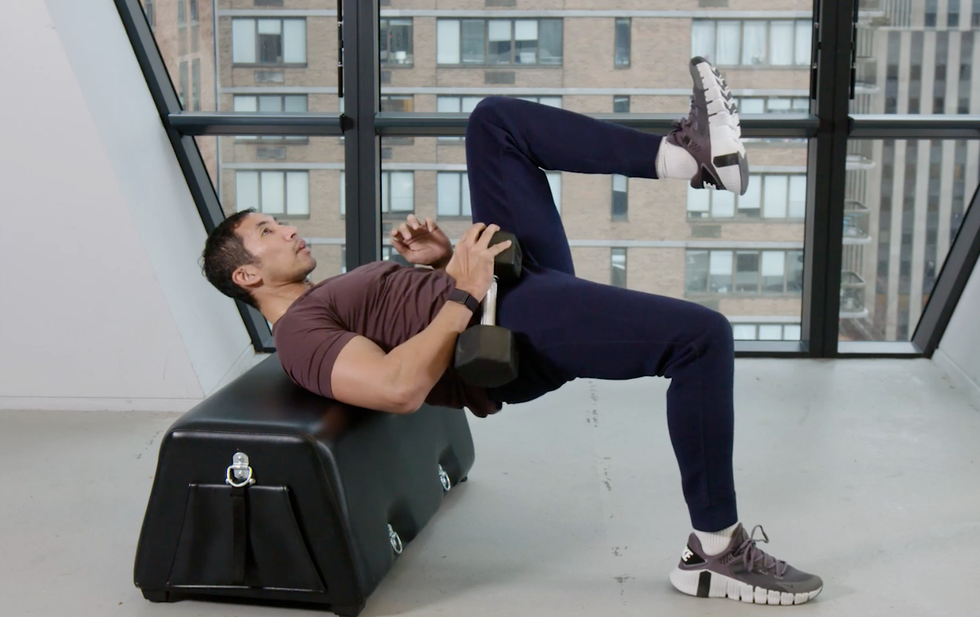YOUR GLUTES ARE more than just eye candy for the rest of the gym to gawk at, no matter what you see on social media. The glutes are one of your strongest muscle groups, so it’s more than just good for your ego to blast that booty with hard and heavy weights.
One of the most common and effective glutes exercises is the barbell hip thrust. Essentially, you stack a few 45s on each side of a barbell, get in position, and drive your hips to the ceiling. But when you don’t have access to a whole lot of weights, there are other glute-training options to go to—namely, the single-leg hip thrust.
Despite the massive reduction in load compared to the barbell hip thrust, this single-leg variation is a viable alternative for all types of gym-goers, says Men’s Health fitness director Ebenezer Samuel, C.S.C.S.
Who Should Do the Single-Leg Hip Thrust
This is an exercise that pretty much anyone can not only perform on a regular basis, but score major results with as well. However, the single-leg hip thrust may be best suited for those training at home or perhaps traveling and are in search of a quick, effective workout.
With or without weights, the single-leg hip thrust can be a great variation for athletes as well. Not only are your glutes getting a whole lot of attention with this move, but you’re also working on hip extension and stability training. All of those factors make this an ideal glute-activation warmup move, especially for runners.
“I think of this as a core exercise—your core, abs, spinal erectors, obliques, and glutes,” Samuel says. “They all come together to help stabilize your spine.”
How to Set Up for a Single Leg Hip Thrust
To master the single-leg hip thrusts, it’s good to get a working understanding of standard hip thrusts.
- Start by placing your shoulder blades on a solid platform—a bench, couch, or chair can work—with your feet spread apart.
- Once set up, think about squeezing your shoulder blades.
- Keeping your shins vertical and perpendicular with the ground, drive your hips up to the ceiling.
As you do this, be aware of your foot placement—too close inside and you’re not getting enough range of motion. If both are extended too far out, your glutes receive a reduction in workload, and that’s not what you’re looking for, so aim for the sweet 90-degree spot at the top foot positioning.
The major difference between the single-leg and bilateral hip thrust setup in in the foot placement. When you get into the single-leg, you should start with your feet together on the floor. From there, lift one foot from the ground, keeping your knee bent simulating a runner’s position. Keeping your hips square to the ceiling—avoid “tilting”—and drive that knee high and maintain it with each rep. This is going to create an added bonus of anti-rotational work as well for your abs as well.
How to Do the Single-Leg Hip Thrust
Once your set, the single-leg hip thrust becomes nice and simple.
- Set your shoulder blades on a bench, couch or solid object, keeping feet close together, shins perpendicular with the floor.
- Lower yourself to the ground
- Pause momentarily, while trying to look forward the entire time.
- Lift one foot off the ground.
- Squeeze your glutes and drive upward, extending one knee to the sky. Hold at the top for about a second or two, focusing on that top squeeze. That’s one rep.
Avoid arching your back. Instead, work on keeping your abs nice and tight before driving to the top.
How to Add Load to the Single-Leg Hip Thrust
Standard hip thrusts are all about working with big loads. The single-leg hip thrust doesn’t have the same focus, and it’s an effective bodyweight movement (especially when you focus on the squeezing your glutes to create tension). To add some load and create a greater challenge, try holding a kettlebell or dumbbell (if you have one). Place the weight on one hip, and hold it with one or even two hands for stability.
You won’t be working with a massive amount of weight, but by adding some load, you’ll be getting some athletic benefits (along with challenging your core even more).
When to Do the Single-Leg Hip Thrust
There are many ways to incorporate the single-leg hip thrust into your routine. If you’re a beginner, it’s wise to work on mastering the standard hip thrust before regularly utilizing this move, which eventually would make a great addition to a bodyweight circuit.
For more advanced, this makes a great warmup glute activation warmup right before attacking deadlifts and squats. And even though you may be used to using heavy weight with classic hip thrusts, you can still incorporate single-leg hip thrusts into your warmup using just your bodyweight. It’s a great way to get your glutes firing and get them warmed pre-squat or deadlift.
Single-Leg Hip Thrust Sets and Reps
Because it’s a lighter weight exercise, three sets using higher reps—think 12 to 15 per side with minimal rest—should work well to get benefits. These can be done as a finishing movement to your bodyweight workout.
Jeff Tomko is a freelance fitness writer who has written for Muscle and Fitness, Men’s Fitness, and Men’s Health.



Comments are closed.